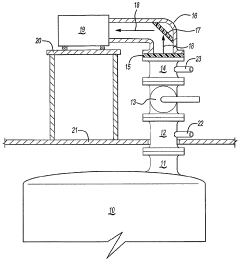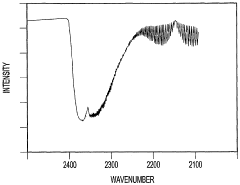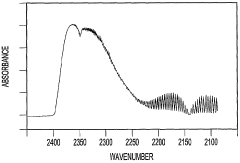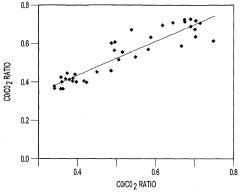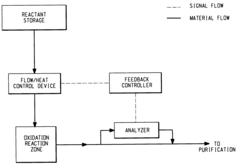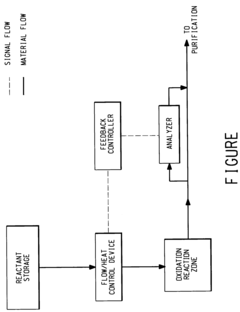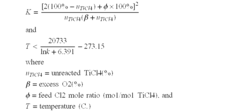How to Assess Carbon Tetrachloride Risks in Production Facilities?
JUL 2, 20259 MIN READ
Generate Your Research Report Instantly with AI Agent
Patsnap Eureka helps you evaluate technical feasibility & market potential.
CCl4 Risk Assessment Background and Objectives
Carbon tetrachloride (CCl4) has been a significant concern in industrial settings due to its potential health and environmental risks. The assessment of CCl4 risks in production facilities is crucial for ensuring worker safety, environmental protection, and regulatory compliance. This technical research report aims to provide a comprehensive overview of the background and objectives of CCl4 risk assessment in industrial environments.
The use of carbon tetrachloride in various industrial processes has a long history, dating back to the early 20th century. Initially employed as a solvent, fire extinguishing agent, and refrigerant, its applications have evolved over time. However, the recognition of its harmful effects on human health and the environment has led to increased scrutiny and regulation of its use in recent decades.
The primary objective of CCl4 risk assessment in production facilities is to identify, evaluate, and mitigate potential hazards associated with its presence and use. This involves a multifaceted approach that considers various exposure routes, including inhalation, dermal contact, and accidental ingestion. The assessment aims to quantify the likelihood and severity of adverse effects on workers, surrounding communities, and ecosystems.
One of the key drivers for CCl4 risk assessment is the growing body of evidence linking exposure to serious health issues. These include liver and kidney damage, central nervous system depression, and potential carcinogenicity. Additionally, CCl4 has been identified as an ozone-depleting substance, contributing to global environmental concerns and necessitating stringent control measures.
The technological evolution in risk assessment methodologies has significantly influenced the approach to evaluating CCl4 hazards. Advanced monitoring techniques, computational modeling, and data analytics have enhanced the accuracy and comprehensiveness of risk evaluations. These technological advancements allow for more precise measurement of CCl4 concentrations, better prediction of exposure scenarios, and improved understanding of long-term health and environmental impacts.
In the context of production facilities, CCl4 risk assessment objectives extend beyond mere compliance with regulatory standards. They encompass the development of robust safety protocols, implementation of effective engineering controls, and establishment of comprehensive emergency response plans. The assessment also aims to inform decision-making processes regarding the continued use of CCl4, potential substitutions, and optimization of production processes to minimize risks.
The global regulatory landscape surrounding CCl4 use and management has become increasingly stringent, shaping the objectives of risk assessment initiatives. International agreements such as the Montreal Protocol have set targets for phasing out CCl4 production and consumption, necessitating a reevaluation of its role in industrial processes and a focus on finding safer alternatives.
The use of carbon tetrachloride in various industrial processes has a long history, dating back to the early 20th century. Initially employed as a solvent, fire extinguishing agent, and refrigerant, its applications have evolved over time. However, the recognition of its harmful effects on human health and the environment has led to increased scrutiny and regulation of its use in recent decades.
The primary objective of CCl4 risk assessment in production facilities is to identify, evaluate, and mitigate potential hazards associated with its presence and use. This involves a multifaceted approach that considers various exposure routes, including inhalation, dermal contact, and accidental ingestion. The assessment aims to quantify the likelihood and severity of adverse effects on workers, surrounding communities, and ecosystems.
One of the key drivers for CCl4 risk assessment is the growing body of evidence linking exposure to serious health issues. These include liver and kidney damage, central nervous system depression, and potential carcinogenicity. Additionally, CCl4 has been identified as an ozone-depleting substance, contributing to global environmental concerns and necessitating stringent control measures.
The technological evolution in risk assessment methodologies has significantly influenced the approach to evaluating CCl4 hazards. Advanced monitoring techniques, computational modeling, and data analytics have enhanced the accuracy and comprehensiveness of risk evaluations. These technological advancements allow for more precise measurement of CCl4 concentrations, better prediction of exposure scenarios, and improved understanding of long-term health and environmental impacts.
In the context of production facilities, CCl4 risk assessment objectives extend beyond mere compliance with regulatory standards. They encompass the development of robust safety protocols, implementation of effective engineering controls, and establishment of comprehensive emergency response plans. The assessment also aims to inform decision-making processes regarding the continued use of CCl4, potential substitutions, and optimization of production processes to minimize risks.
The global regulatory landscape surrounding CCl4 use and management has become increasingly stringent, shaping the objectives of risk assessment initiatives. International agreements such as the Montreal Protocol have set targets for phasing out CCl4 production and consumption, necessitating a reevaluation of its role in industrial processes and a focus on finding safer alternatives.
Industrial Demand for CCl4 Risk Management
The industrial demand for Carbon Tetrachloride (CCl4) risk management has grown significantly in recent years, driven by increasing regulatory pressure and a heightened awareness of environmental and health concerns. Production facilities that utilize or produce CCl4 face substantial challenges in managing the associated risks, necessitating robust assessment and mitigation strategies.
CCl4 is primarily used as a feedstock for the production of chlorofluorocarbons (CFCs) and their alternatives, as well as in various industrial processes such as metal degreasing and as a solvent in chemical synthesis. Despite its utility, CCl4 is classified as a hazardous air pollutant and ozone-depleting substance, subject to strict regulations under international agreements like the Montreal Protocol.
The demand for effective CCl4 risk management stems from several factors. Firstly, regulatory compliance requirements have become more stringent, with many countries implementing stricter emission controls and reporting obligations. This has compelled production facilities to invest in advanced monitoring systems and risk assessment protocols to ensure adherence to legal standards and avoid potential penalties.
Secondly, there is growing pressure from stakeholders, including investors, customers, and local communities, for companies to demonstrate responsible environmental stewardship. This has led to an increased focus on transparency in risk management practices and the adoption of more comprehensive environmental, social, and governance (ESG) policies.
Furthermore, the potential financial implications of CCl4-related incidents, such as accidental releases or worker exposure, have underscored the importance of proactive risk management. Insurance premiums, liability concerns, and the costs associated with cleanup and remediation have all contributed to the industrial demand for more sophisticated risk assessment and mitigation strategies.
In response to these demands, the market has seen a rise in specialized consulting services and technological solutions aimed at CCl4 risk management. These include advanced leak detection systems, real-time monitoring equipment, and software platforms for risk assessment and compliance tracking. Additionally, there has been an increased emphasis on employee training programs and the development of standardized protocols for handling and storing CCl4.
The industrial sector has also witnessed a trend towards the exploration of alternative substances and processes that could reduce or eliminate the use of CCl4 altogether. This shift is driven by both risk management considerations and the long-term sustainability goals of many companies.
As global environmental regulations continue to evolve and public awareness of chemical risks grows, the demand for comprehensive CCl4 risk management in production facilities is expected to remain strong. This ongoing trend underscores the critical importance of developing and implementing effective strategies to assess and mitigate CCl4-related risks in industrial settings.
CCl4 is primarily used as a feedstock for the production of chlorofluorocarbons (CFCs) and their alternatives, as well as in various industrial processes such as metal degreasing and as a solvent in chemical synthesis. Despite its utility, CCl4 is classified as a hazardous air pollutant and ozone-depleting substance, subject to strict regulations under international agreements like the Montreal Protocol.
The demand for effective CCl4 risk management stems from several factors. Firstly, regulatory compliance requirements have become more stringent, with many countries implementing stricter emission controls and reporting obligations. This has compelled production facilities to invest in advanced monitoring systems and risk assessment protocols to ensure adherence to legal standards and avoid potential penalties.
Secondly, there is growing pressure from stakeholders, including investors, customers, and local communities, for companies to demonstrate responsible environmental stewardship. This has led to an increased focus on transparency in risk management practices and the adoption of more comprehensive environmental, social, and governance (ESG) policies.
Furthermore, the potential financial implications of CCl4-related incidents, such as accidental releases or worker exposure, have underscored the importance of proactive risk management. Insurance premiums, liability concerns, and the costs associated with cleanup and remediation have all contributed to the industrial demand for more sophisticated risk assessment and mitigation strategies.
In response to these demands, the market has seen a rise in specialized consulting services and technological solutions aimed at CCl4 risk management. These include advanced leak detection systems, real-time monitoring equipment, and software platforms for risk assessment and compliance tracking. Additionally, there has been an increased emphasis on employee training programs and the development of standardized protocols for handling and storing CCl4.
The industrial sector has also witnessed a trend towards the exploration of alternative substances and processes that could reduce or eliminate the use of CCl4 altogether. This shift is driven by both risk management considerations and the long-term sustainability goals of many companies.
As global environmental regulations continue to evolve and public awareness of chemical risks grows, the demand for comprehensive CCl4 risk management in production facilities is expected to remain strong. This ongoing trend underscores the critical importance of developing and implementing effective strategies to assess and mitigate CCl4-related risks in industrial settings.
Current CCl4 Hazard Identification Methods
Carbon tetrachloride (CCl4) hazard identification in production facilities is a critical process that involves several established methods. One of the primary approaches is the use of comprehensive risk assessment protocols. These protocols typically include a systematic evaluation of potential exposure routes, such as inhalation, skin contact, and ingestion. Facilities often employ air monitoring systems to detect CCl4 vapors, which can be highly toxic when inhaled. These systems use advanced sensors and gas chromatography techniques to provide real-time data on CCl4 concentrations in the air.
Another key method is the implementation of regular workplace inspections and audits. These assessments focus on identifying potential sources of CCl4 release, such as leaks in storage tanks, pipelines, or process equipment. Inspectors use specialized equipment like infrared cameras to detect invisible vapor leaks and conduct pressure tests to identify potential weak points in containment systems.
Material safety data sheets (MSDS) play a crucial role in hazard identification. These documents provide detailed information about CCl4's physical and chemical properties, health effects, and proper handling procedures. Facilities ensure that up-to-date MSDS are readily available to all personnel and that workers are trained to interpret this information correctly.
Biological monitoring is another important aspect of CCl4 hazard identification. This involves regular medical check-ups and blood tests for workers potentially exposed to CCl4. These tests can detect early signs of CCl4 exposure and help prevent long-term health effects. Additionally, some facilities use biomarkers to assess the level of CCl4 or its metabolites in workers' bodies.
Advanced modeling and simulation techniques are increasingly being used to predict potential CCl4 exposure scenarios. These computer-based tools can simulate various accident scenarios, helping facilities identify high-risk areas and develop targeted prevention strategies. Such models often incorporate factors like facility layout, ventilation systems, and typical work processes to provide a comprehensive risk assessment.
Lastly, many facilities are adopting a holistic approach to hazard identification by integrating CCl4 risk assessment into their overall process safety management systems. This involves regular review of operating procedures, emergency response plans, and training programs to ensure they adequately address CCl4-specific risks. By combining these various methods, production facilities can create a robust framework for identifying and mitigating CCl4 hazards, thereby enhancing worker safety and environmental protection.
Another key method is the implementation of regular workplace inspections and audits. These assessments focus on identifying potential sources of CCl4 release, such as leaks in storage tanks, pipelines, or process equipment. Inspectors use specialized equipment like infrared cameras to detect invisible vapor leaks and conduct pressure tests to identify potential weak points in containment systems.
Material safety data sheets (MSDS) play a crucial role in hazard identification. These documents provide detailed information about CCl4's physical and chemical properties, health effects, and proper handling procedures. Facilities ensure that up-to-date MSDS are readily available to all personnel and that workers are trained to interpret this information correctly.
Biological monitoring is another important aspect of CCl4 hazard identification. This involves regular medical check-ups and blood tests for workers potentially exposed to CCl4. These tests can detect early signs of CCl4 exposure and help prevent long-term health effects. Additionally, some facilities use biomarkers to assess the level of CCl4 or its metabolites in workers' bodies.
Advanced modeling and simulation techniques are increasingly being used to predict potential CCl4 exposure scenarios. These computer-based tools can simulate various accident scenarios, helping facilities identify high-risk areas and develop targeted prevention strategies. Such models often incorporate factors like facility layout, ventilation systems, and typical work processes to provide a comprehensive risk assessment.
Lastly, many facilities are adopting a holistic approach to hazard identification by integrating CCl4 risk assessment into their overall process safety management systems. This involves regular review of operating procedures, emergency response plans, and training programs to ensure they adequately address CCl4-specific risks. By combining these various methods, production facilities can create a robust framework for identifying and mitigating CCl4 hazards, thereby enhancing worker safety and environmental protection.
Existing CCl4 Risk Mitigation Strategies
01 Health and environmental hazards
Carbon tetrachloride poses significant risks to human health and the environment. It is known to be toxic, carcinogenic, and can cause liver and kidney damage. Exposure can occur through inhalation, skin contact, or ingestion. It also contributes to ozone depletion and has been phased out in many applications due to its harmful effects.- Health and environmental hazards: Carbon tetrachloride poses significant risks to human health and the environment. It is known to be toxic, potentially carcinogenic, and can cause damage to the liver, kidneys, and central nervous system. Exposure can occur through inhalation, skin contact, or ingestion. It also contributes to ozone depletion and global warming when released into the atmosphere.
- Industrial applications and alternatives: Despite its risks, carbon tetrachloride has been used in various industrial applications, including as a solvent, cleaning agent, and in the production of refrigerants. However, due to its hazardous nature, efforts have been made to find safer alternatives and phase out its use in many industries.
- Detection and monitoring methods: To mitigate risks associated with carbon tetrachloride, various detection and monitoring methods have been developed. These include analytical techniques for measuring its presence in air, water, and soil, as well as systems for early warning and continuous monitoring in industrial settings.
- Remediation and treatment technologies: Given the persistent nature of carbon tetrachloride contamination, research has focused on developing effective remediation and treatment technologies. These include physical, chemical, and biological methods for removing or degrading carbon tetrachloride in contaminated soil and groundwater.
- Regulatory measures and safety protocols: To address the risks associated with carbon tetrachloride, various regulatory measures and safety protocols have been implemented. These include restrictions on its production and use, guidelines for proper handling and disposal, and occupational safety standards to protect workers who may be exposed to the substance.
02 Industrial applications and alternatives
Despite its risks, carbon tetrachloride has been used in various industrial applications, including as a solvent, cleaning agent, and in the production of refrigerants. However, due to its hazardous nature, efforts have been made to find safer alternatives and phase out its use in many industries.Expand Specific Solutions03 Detection and monitoring methods
To mitigate risks associated with carbon tetrachloride, various detection and monitoring methods have been developed. These include analytical techniques for measuring its presence in air, water, and soil, as well as systems for early warning and continuous monitoring in industrial settings.Expand Specific Solutions04 Remediation and treatment techniques
Given the persistent nature of carbon tetrachloride contamination, various remediation and treatment techniques have been developed. These include physical, chemical, and biological methods for removing or degrading carbon tetrachloride in contaminated soil and groundwater.Expand Specific Solutions05 Regulatory measures and safety protocols
Due to the known risks of carbon tetrachloride, numerous regulatory measures and safety protocols have been implemented globally. These include restrictions on its production and use, guidelines for proper handling and disposal, and occupational safety standards to protect workers who may be exposed to the substance.Expand Specific Solutions
Key Players in CCl4 Safety and Monitoring
The carbon tetrachloride risk assessment landscape in production facilities is characterized by a mature market with established players and evolving regulatory standards. Major chemical companies like DuPont, Bayer, and ExxonMobil are at the forefront of developing risk assessment methodologies and mitigation strategies. The market is driven by increasing environmental regulations and workplace safety concerns. Technological advancements in detection and monitoring systems are enhancing risk assessment capabilities. Academic institutions like Nanjing University and Changzhou University contribute to research and innovation in this field, collaborating with industry partners to improve safety protocols and risk management techniques.
DuPont de Nemours, Inc.
Technical Solution: DuPont has developed a comprehensive risk assessment framework for carbon tetrachloride in production facilities. Their approach includes advanced air monitoring systems using gas chromatography-mass spectrometry (GC-MS) for real-time detection of CCl4 at parts per billion levels[1]. They have implemented a multi-tiered containment strategy, utilizing specialized seals and double-walled piping to minimize leaks. DuPont's risk mitigation plan incorporates predictive maintenance schedules based on machine learning algorithms to identify potential equipment failures before they lead to CCl4 releases[2]. Additionally, they have developed a proprietary software tool that integrates process data, environmental conditions, and historical incident reports to provide dynamic risk profiles for different areas of the facility[3].
Strengths: Comprehensive approach combining advanced technology and data analytics. Weaknesses: High implementation costs and potential over-reliance on technology.
The Chemours Co.
Technical Solution: Chemours has implemented a holistic approach to assessing carbon tetrachloride risks in their production facilities. They utilize a combination of engineering controls and administrative measures. Their system includes continuous emission monitoring systems (CEMS) that can detect CCl4 at low concentrations, coupled with automated shutdown procedures if threshold levels are exceeded[4]. Chemours has also developed a risk matrix that considers factors such as process conditions, equipment age, and maintenance history to prioritize areas for enhanced monitoring and control. They have implemented a closed-loop production system that minimizes potential exposure points and incorporates regenerative thermal oxidizers to destroy any CCl4 emissions[5].
Strengths: Integrated approach combining monitoring, process design, and destruction technologies. Weaknesses: Potential for high energy consumption in emission control systems.
Innovative Approaches to CCl4 Exposure Control
Method for the analysis of gas produced by a titanium tetrachloride fluidized bed reactor
PatentWO2004104518A1
Innovation
- A method that uses infrared radiation from the fluidized bed reactor to determine the ratio of infrared absorption intensity of components like carbon monoxide and carbon dioxide or carbonyl sulfide and sulfur dioxide without sampling, by directing infrared radiation through the gaseous products to an infrared spectrometer, analyzing specific wavenumbers for absorption intensity, and calculating concentration ratios using calibration factors.
Process for making titanium dioxide
PatentActiveUS7638113B2
Innovation
- Implementing an analyzer to detect and control the concentration of titanium tetrachloride and silicon tetrachloride in the process stream, adjusting oxidation and mixing conditions to maintain optimal concentrations, and using silicon tetrachloride for surface treatment of titanium dioxide.
Regulatory Framework for CCl4 in Industry
The regulatory framework for carbon tetrachloride (CCl4) in industry is complex and multifaceted, reflecting the compound's significant environmental and health risks. At the international level, the Montreal Protocol on Substances that Deplete the Ozone Layer has been instrumental in phasing out CCl4 production and consumption for most uses. This treaty, ratified by 198 countries, has led to a dramatic reduction in global CCl4 emissions since its implementation in 1989.
In the United States, the Environmental Protection Agency (EPA) regulates CCl4 under several statutes. The Toxic Substances Control Act (TSCA) lists CCl4 as a priority chemical, subjecting it to risk evaluations and potential restrictions. The Clean Air Act classifies CCl4 as a hazardous air pollutant, requiring strict emission controls in industrial settings. Additionally, the Safe Drinking Water Act establishes a maximum contaminant level for CCl4 in public water systems.
The Occupational Safety and Health Administration (OSHA) sets permissible exposure limits for CCl4 in the workplace. These standards mandate that employee exposure must not exceed 10 parts per million (ppm) as an 8-hour time-weighted average. OSHA also requires employers to implement engineering controls, work practices, and personal protective equipment to minimize worker exposure.
In the European Union, the Registration, Evaluation, Authorisation and Restriction of Chemicals (REACH) regulation governs the use of CCl4. Under REACH, CCl4 is classified as a substance of very high concern due to its carcinogenic properties. This classification imposes strict requirements on manufacturers, importers, and downstream users, including the need for authorization for specific uses.
Many countries have implemented their own regulatory frameworks for CCl4, often aligning with international agreements while tailoring requirements to local conditions. For instance, China has established a licensing system for CCl4 production and use, with stringent controls on emissions and disposal.
Industry-specific regulations also play a crucial role in managing CCl4 risks. In the pharmaceutical sector, where CCl4 is still used in some processes, Good Manufacturing Practices (GMP) guidelines incorporate specific measures for handling and containing this hazardous substance. Similarly, the semiconductor industry has developed protocols for the safe use and disposal of CCl4 in cleaning and etching processes.
As scientific understanding of CCl4's environmental and health impacts continues to evolve, regulatory frameworks are regularly updated. This dynamic regulatory landscape necessitates ongoing vigilance and adaptation from industries that still rely on CCl4, ensuring compliance with current standards while preparing for potential future restrictions.
In the United States, the Environmental Protection Agency (EPA) regulates CCl4 under several statutes. The Toxic Substances Control Act (TSCA) lists CCl4 as a priority chemical, subjecting it to risk evaluations and potential restrictions. The Clean Air Act classifies CCl4 as a hazardous air pollutant, requiring strict emission controls in industrial settings. Additionally, the Safe Drinking Water Act establishes a maximum contaminant level for CCl4 in public water systems.
The Occupational Safety and Health Administration (OSHA) sets permissible exposure limits for CCl4 in the workplace. These standards mandate that employee exposure must not exceed 10 parts per million (ppm) as an 8-hour time-weighted average. OSHA also requires employers to implement engineering controls, work practices, and personal protective equipment to minimize worker exposure.
In the European Union, the Registration, Evaluation, Authorisation and Restriction of Chemicals (REACH) regulation governs the use of CCl4. Under REACH, CCl4 is classified as a substance of very high concern due to its carcinogenic properties. This classification imposes strict requirements on manufacturers, importers, and downstream users, including the need for authorization for specific uses.
Many countries have implemented their own regulatory frameworks for CCl4, often aligning with international agreements while tailoring requirements to local conditions. For instance, China has established a licensing system for CCl4 production and use, with stringent controls on emissions and disposal.
Industry-specific regulations also play a crucial role in managing CCl4 risks. In the pharmaceutical sector, where CCl4 is still used in some processes, Good Manufacturing Practices (GMP) guidelines incorporate specific measures for handling and containing this hazardous substance. Similarly, the semiconductor industry has developed protocols for the safe use and disposal of CCl4 in cleaning and etching processes.
As scientific understanding of CCl4's environmental and health impacts continues to evolve, regulatory frameworks are regularly updated. This dynamic regulatory landscape necessitates ongoing vigilance and adaptation from industries that still rely on CCl4, ensuring compliance with current standards while preparing for potential future restrictions.
Environmental Impact of CCl4 in Manufacturing
Carbon tetrachloride (CCl4) has been widely used in manufacturing processes for decades, but its environmental impact has become a growing concern. The release of CCl4 into the environment can have severe consequences for ecosystems and human health. In production facilities, CCl4 emissions primarily occur through air and water pollution, as well as soil contamination.
Air pollution is a significant concern, as CCl4 is highly volatile and can easily evaporate into the atmosphere. Once released, it contributes to the depletion of the ozone layer, which protects the Earth from harmful ultraviolet radiation. The atmospheric lifetime of CCl4 is estimated to be around 26 years, making its impact long-lasting and far-reaching.
Water pollution occurs when CCl4 is improperly disposed of or leaks into water sources. Due to its low solubility in water, CCl4 tends to sink and form dense non-aqueous phase liquids (DNAPLs) in groundwater. This contamination can persist for extended periods, posing a threat to aquatic ecosystems and potentially entering the food chain.
Soil contamination is another significant environmental impact of CCl4 in manufacturing. Spills or improper disposal can lead to the accumulation of CCl4 in soil, where it can remain for long periods due to its resistance to biodegradation. This persistence in soil can lead to long-term environmental damage and potential exposure risks for humans and wildlife.
The environmental impact of CCl4 extends beyond local ecosystems. Its contribution to ozone depletion has global consequences, affecting climate patterns and increasing the risk of skin cancer and other health issues in populations worldwide. Additionally, CCl4 is a potent greenhouse gas, with a global warming potential approximately 1,400 times that of carbon dioxide over a 100-year time frame.
To mitigate these environmental impacts, manufacturing facilities must implement strict control measures. These include proper handling and storage protocols, advanced emission control technologies, and comprehensive waste management systems. Regular monitoring of air, water, and soil quality in and around production facilities is essential to detect and address potential contamination promptly.
Furthermore, the development and adoption of alternative substances and processes that can replace CCl4 in manufacturing are crucial for long-term environmental protection. This shift towards more environmentally friendly practices not only reduces the direct impact of CCl4 but also contributes to overall sustainability in industrial operations.
Air pollution is a significant concern, as CCl4 is highly volatile and can easily evaporate into the atmosphere. Once released, it contributes to the depletion of the ozone layer, which protects the Earth from harmful ultraviolet radiation. The atmospheric lifetime of CCl4 is estimated to be around 26 years, making its impact long-lasting and far-reaching.
Water pollution occurs when CCl4 is improperly disposed of or leaks into water sources. Due to its low solubility in water, CCl4 tends to sink and form dense non-aqueous phase liquids (DNAPLs) in groundwater. This contamination can persist for extended periods, posing a threat to aquatic ecosystems and potentially entering the food chain.
Soil contamination is another significant environmental impact of CCl4 in manufacturing. Spills or improper disposal can lead to the accumulation of CCl4 in soil, where it can remain for long periods due to its resistance to biodegradation. This persistence in soil can lead to long-term environmental damage and potential exposure risks for humans and wildlife.
The environmental impact of CCl4 extends beyond local ecosystems. Its contribution to ozone depletion has global consequences, affecting climate patterns and increasing the risk of skin cancer and other health issues in populations worldwide. Additionally, CCl4 is a potent greenhouse gas, with a global warming potential approximately 1,400 times that of carbon dioxide over a 100-year time frame.
To mitigate these environmental impacts, manufacturing facilities must implement strict control measures. These include proper handling and storage protocols, advanced emission control technologies, and comprehensive waste management systems. Regular monitoring of air, water, and soil quality in and around production facilities is essential to detect and address potential contamination promptly.
Furthermore, the development and adoption of alternative substances and processes that can replace CCl4 in manufacturing are crucial for long-term environmental protection. This shift towards more environmentally friendly practices not only reduces the direct impact of CCl4 but also contributes to overall sustainability in industrial operations.
Unlock deeper insights with Patsnap Eureka Quick Research — get a full tech report to explore trends and direct your research. Try now!
Generate Your Research Report Instantly with AI Agent
Supercharge your innovation with Patsnap Eureka AI Agent Platform!
